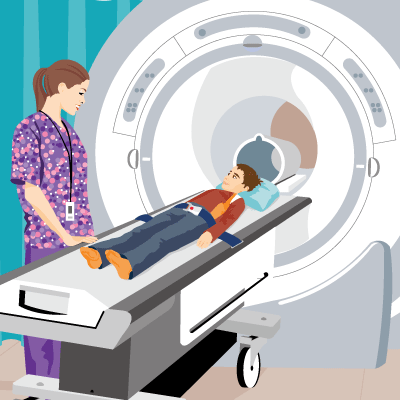Mra Kids
Mra Kids
What It Is
Magnetic resonance imaging (MRI) of the lumbar spine is a safe and painless test that uses a magnetic field and radio waves to produce detailed pictures of the lumbar spine (the bones, disks, and other structures in the lower back).
An MRI differs from a CAT scan (also called a CT scan or a computed axial tomography scan) because it does not use radiation. An MRI scanner consists of a large doughnut-shaped magnet that often has a tunnel in the center. Patients are placed on a table that slides into the tunnel. Some centers have open MRI machines that have larger openings and are helpful for patients with claustrophobia. MRI machines are located in hospitals and radiology centers.
During the examination, radio waves manipulate the magnetic positions of the atoms of the body, which are picked up by a powerful antenna and sent to a computer. The computer performs millions of calculations used to create cross-sectional, black and white images of the body. These images can be reconstructed into three-dimensional (3-D) pictures of the scanned area. This helps to pinpoint problems in the lumbar spine when the scan focuses on that area.
Why It's Done
MRI can detect a variety of conditions of the lumbar spine, including problems with the bones (vertebrae), soft tissues (such as the spinal cord), nerves, and disks.
An MRI sometimes is performed to assess the anatomy of the lumbar spine, to help plan surgery on the spine, or to monitor changes in the spine after an operation. For example, it can find areas of the spine where the spinal canal (which contains the spinal cord) is abnormally narrowed and might require surgery. It can assess the disks to see whether they are bulging, ruptured, or pressing on the spinal cord or nerves.
MRI of the lumbar spine can be useful in evaluating symptoms such as lower back pain, leg pain, numbness, tingling or weakness, or problems with bladder and bowel control. It can also help to diagnose tumors, bleeding, swelling, developmental or structural abnormalities, and infections or inflammatory conditions in the vertebrae or surrounding tissues.

p
Preparation
A lumbar spine MRI usually doesn't require any special preparation. However, the technician will have your child remove any objects containing metal (such as eyeglasses and jewelry) because they can produce a bright or blank spot on the diagnostic film (but braces and dental fillings won't interfere with the scan). You'll also be asked questions to make sure your child doesn't have any internal metal clips from previous surgery or anything else that might cause a problem near a strong magnetic field. Electronic devices aren't permitted in the MRI room.
To obtain the highest quality MRI results, your child will need to stay still during the scan. For this reason, sedation may be required, especially for infants and young kids, who are likely to have difficulty staying still for the test. If sedation is needed, food and liquids will be stopped at a certain point before the MRI to allow your child's stomach to empty. It's important to notify the MRI technician of any illness, allergy, previous drug reactions, or pregnancy.
Sedation medications are usually given through an intravenous (IV) line (small tube in a vein) to help a child stay asleep during the entire test. Sedation is also helpful for kids who are claustrophobic. To relieve anxiety before and during the test, some patients take an oral sedative on the way to the hospital or radiology center.
You can stay in the MRI room with your child until the test begins, and in some centers you may be able to stay throughout the test. Otherwise, you'll join the technician in an outer room or be asked to stay in a waiting room.
If you're nearby, you'll be able to watch through a large window and talk to your child through an intercom during breaks between the scans. This can soothe your child if he or she is awake in the MRI machine.
p
Procedure
A lumbar spine MRI usually takes about 30-60 minutes to perform. Your child will lie on the movable scanning table while the technologist places him or her into position. A special plastic device called a coil may be placed around your child's head. The table will slide into the tunnel and the technician will take images of the lumbar spine. Each scan takes a few minutes.

As the exam proceeds, your child will hear repetitive sounds from the machine, which are normal. Your child may be given headphones to listen to music or earplugs to block the noise, and will have access to a call button in case he or she becomes uneasy during the test. If sedated, your child will be monitored at all times and will be connected to a machine that checks the heartbeat, breathing, and oxygen level.
Once the exam is over, the technician will help your child off the table; if sedation was used, your child may be moved to a recovery area.
p
What to Expect
MRIs are painless. Your child may have to lie still on the MRI table for 30-60 minutes during this procedure, but there are brief breaks between each scan. If your child feels cold lying on the MRI table, a blanket can be provided.
Unless sedation is used or you are told otherwise, your child can immediately return to normal routine and diet. Most sedation will wear off within 1-2 hours.
Getting the Results
The MRI images will be looked at by a radiologist who's specially trained in interpreting the scans. The radiologist will send a report to your doctor, who will discuss the results with you and explain what they mean. In most cases, results can't be given directly to the patient or family at the time of the test.
If the MRI was done on an emergency basis, the results can be made available quickly.
Risks
MRIs are safe and easy. No health risks have been associated with the magnetic field or low-energy radio waves that are used for the test. The procedure can be repeated without side effects.
If your child requires sedation, you may discuss the risks and benefits of sedation with your provider.
Helping Your Child
You can help your child prepare for an MRI by explaining the test in simple terms before the examination. Make sure you explain that the lower back will be examined and that the equipment will probably make knocking and buzzing noises.
It may also help to remind your child that you'll be nearby during the entire test.
If your child is going to be awake for the test, be sure to explain the importance of lying still. Your doctor may suggest that you and your child take a tour of the MRI room before the test.
If You Have Questions
If you have questions about the MRI procedure, speak with your doctor. You can also talk to the MRI technician before the exam.
Source: https://kidshealth.org/en/parents/mri-lumbar.html


Tidak ada komentar:
Tulis komentar